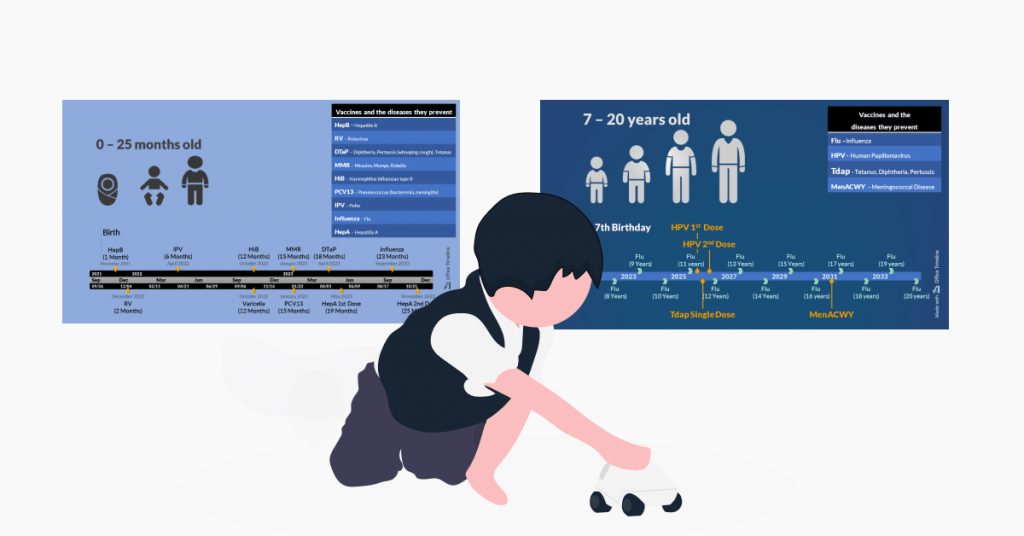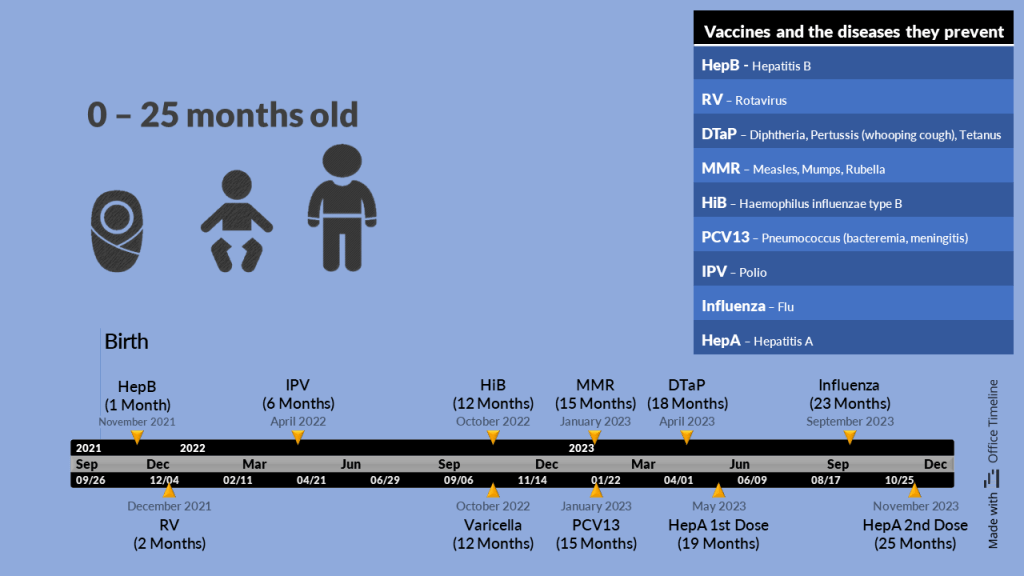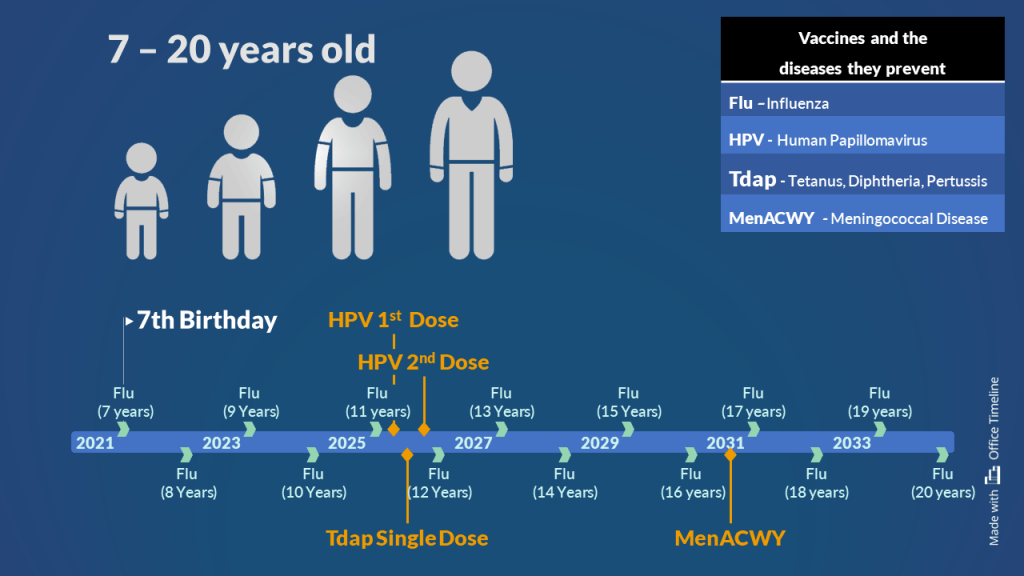
Vaccines have become a subject of intense discussion in recent years. The role of this article is not to debate viewpoints or pick sides. Rather, we aim to cover the origins of this practice, and illustrate the CDC recommendations on the best time to receive a certain shot depending on the age of the recipient. This article also offers two colorful timelines for reference, so you can have a clear overview of what’s recommended for each age bracket. Let’s find out more.
Immunization practices: then and now
The notion of exposing oneself to harmful factors to build up immunity is not new. Buddhist monks would, for instance, ingest trace amounts of snake venom in order minimize their body’s response to the bite. Another practice – perhaps closer to the concept of vaccines – dates back to 17th century China, when people routinely smeared cowpox on open wounds to develop immunity to smallpox. However, it was only after we’ve had microscopes – and learned about the existence of microorganisms – that we were able to develop functional vaccines. In our History of vaccines timeline you can find some of deadliest transmittable diseases and the dates when we came up with vaccines for them.
There are still multiple diseases for which science still hasn’t found a vaccine, like Lyme, West Nile, Zika or hepatitis C, to name a few. Generally, the blocker comes from the rapid mutation of the virus which does not allow antibodies to ‘lock onto them’ or, like in the case of HIV, when the virus hijacks the immune cells themselves. Things are even more complicated when it comes to bacterial infections; for instance, tuberculosis is able to survive being ‘walled in’ by white cells. But while those vaccines are in the works, let’s find out when the CDC recommends getting inoculated with the available shots.
What are the recommended vaccinations and when should they be administered?
Before we proceed to answering this question, let’s make a couple of notes. First off, the following immunization timelines are not designed as a definitive, one-size-fits-all guide. We will assume ideal health and no preexisting conditions for our ‘patient’. We’ll also work under the premise that the environment that does not present high risks of very specific infections, at least not more so than the average modern household. Finally, as with all medical procedures, your paediatrician should have the final word in the selecting the vaccination dates, type of vaccine and number of doses to be administered.
In short, what we’re providing here is a general overview of the main types of vaccines that are recommended under ideal conditions and the optimal dates of administration. Do note that missing a shot is not the end of the world; you can reschedule them for later dates under the guidelines listed by the CDC, WHO and your medical practitioner. However, due to the highly specific nature of each situation, we won’t be going into that. As a side note, you can always download our vaccination timelines and replace the default data with the vaccination details established by your doctor.
Vaccination schedule from birth to 2 years old
Let’s meet baby Johnny!
Johnny isn’t a huge fan of needles and doesn’t think being slapped on the bottom is the best welcome for someone who’s just been born. Nonetheless, Johnny still has a lot to learn about the world and for now, he must rely on the experience of his parents to guide his first steps. Over the next months, he will receive a few immunization shots. Their role is to ensure his tiny immune system is equipped to handle dangerous pathogens, by having a threat response protocol at the ready. Here’s a timeline of Johnny’s vaccinations during his first 25 months on Earth:

Johnny already received a dose of HepB vaccine at birth, as he was medically stable and with a normal weight. The next one is set for his 1 month anniversary and the final one will be decided by his pediatrician, but it should be scheduled at least 16 months after the original administration.
He’ll receive a single dose of HiB (Haemophilus Influenzae Type B) since his parents scheduled the vaccine within the first 15 months. Unlike this one, however, the regular flu vaccine is something that Johnny will need to get regularly as he grows up.
Why should infants receive immunization shots this early?
Parents, and particularly first-time parents, are often concerned that early vaccination could effectively overload their little ones’ immune system. Still, the many studies conducted by the CDC and WHO suggest these fears are not founded. The immune system of a baby or toddler battles thousands and thousands of active germs on a daily basis. By comparison, the immunization shots only contain a small fraction of the antigens – weakened or dead germ parts – normally found in the baby’s environment. Moreover, these antigens teach the immune system how to create the protective antibodies without triggering the full symptomatology of the disease, giving your baby the tools to ward off serious infections.
Vaccination schedule 7-20 Years
Johnny is growin’ up!
In spite of his tantrums, protests and negotiations, Johnny’s parents took him to get all the vaccines recommended by his pediatrician within the proper intervals. The good news is that Johnny won’t need to get extra doses for long lasting immunity. The only immunization shots still on the list – apart from the yearly flu shots – are Tdap, HPV and the meningococcal conjucate MenACWY. Let’s see what the timeline would look like:

Speaking of flu, the CDC recommendation of yearly vaccination applies to every person over the age of 6 months. Due to the constantly shifting structure of influenza viruses, this appears to be the best option for avoiding a new global pandemic like the Covid-19.
The Tdap shot that protects against tetanus, diphtheria and pertussis is recommended within the 11 to 12 years interval, as a single shot. For HPV, 2 doses are enough for Johnny, since his immune system is strong, but a 3rd booster dose would be necessary for children with a weak immune system.
Special note: Later life vaccination
The CDC recommends getting a shingles & PHN vaccine – preferably with the RZV zoster recombinant Shingrix – for everyone over the age of 60. There’s no maximum age for it, and the chances of contracting shingles is reduced by 51% whereas the risk of PHN is cut down by 67%.
Why should adults get vaccinated?
In addition to weariness about the potential vaccine complications that polarizes global opinions, adults tend to forego immunization shots for two reasons:
- Young age gives them a sense of invincibility, an unwarranted confidence that their immune system can handle just about anything on its own;
- Old age brings along a variety of health issues, so it appears counterintuitive to add to them by willingly introducing antigens – the previously mentioned dead or weakened parts of the virus – in the mix.
And why should you receive immunization for a disease you might not ever contract?
Well, as people say, ‘Better safe than sorry’. The transmittable disease for which you can receive immunization haven’t yet been eradicated completely and some of them carry terrible risks, from cancer to diabetes, renal disease, chronic liver disease and a bunch more. Compared to these, the rare potential complications of vaccines are essentially negligible – but if you have any doubts, please don’t hesitate to discuss them with your doctor.
About the recommended vaccinations timeline
The immunization schedule was created with Office Timeline, an elegant and powerful add-in for PowerPoint that allows you to create amazing presentations within minutes. The free version includes most of the necessary features, but for more complex applications the Pro+ Edition will grant you access to many others, like swimlanes or importing from Excel and Microsoft Project. You can download the vaccination schedules as PowerPoint files and adjust the dates manually or update them with the Office Timeline add-in.